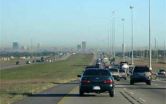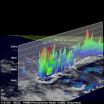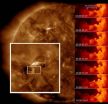(Press-News.org) New research focusing on the Houston area suggests that widespread urban development alters weather patterns in a way that can make it easier for pollutants to accumulate during warm summer weather instead of being blown out to sea.
The international study, led by the National Center for Atmospheric Research (NCAR), could have implications for the air quality of fast-growing coastal cities in the United States and other mid-latitude regions overseas.
The reason: the proliferation of strip malls, subdivisions and other paved areas may interfere with breezes needed to clear away smog and other pollution.
The researchers combined extensive atmospheric measurements with computer simulations to examine the impact of pavement on breezes in Houston.
They found that, because pavement soaks up heat and keeps land areas relatively warm overnight, the contrast between land and sea temperatures is reduced during the summer.
This in turn causes a reduction in nighttime winds that would otherwise blow pollutants out to sea.
In addition, built structures interfere with local winds and contribute to relatively stagnant afternoon conditions.
"The developed area of Houston has a major impact on local air pollution," says NCAR scientist Fei Chen, lead author of the new study. "If the city continues to expand, it's going to make the winds even weaker in the summertime, and that will make air pollution much worse."
While cautioning that more work is needed to better understand the impact of urban development on wind patterns, Chen says the research can eventually help forecasters improve projections of major pollution events.
Policy-makers might also consider new approaches to development as cities work to clean up unhealthy air.
The article will be published this month in the Journal of Geophysical Research, published by the American Geophyiscal Union.
The research was funded by the U.S. Air Force Weather Agency, the U.S. Defense Threat Reduction Agency, and the National Science Foundation (NSF), NCAR's sponsor.
"Growing urbanization and coastal zone populations in Houston and other port cities around the globe make our ability to understand and predict complex interactions between the urban canopy and local sea-breeze circulation ever more critical," says Brad Smull of NSF's Division of Atmospheric and Geospace Sciences." This study represents a significant step toward that objective."
In addition to NCAR, the authors are affiliated with the China Meteorological Administration, the U.S. National Oceanic and Atmospheric Administration and the University of Tsukuba in Japan. The research is built on a number of previous studies on the influence of urban areas on air pollution.
Houston, known for its mix of petrochemical facilities, sprawling suburbs and traffic jams that stretch for miles, has some of the highest levels of ground-level ozone and other air pollutants in the United States.
State and federal officials have long worked to regulate emissions from factories and motor vehicles in efforts to improve air quality.
The new study suggests that focusing on the city's development patterns and adding to its already extensive park system could provide air quality benefits as well.
"If you made the city greener and created lakes and ponds, then you probably would have less air pollution even if emissions stayed the same," Chen explains. "The night-time temperature over the city would be lower and winds would become stronger, blowing the pollution out to the Gulf."
Chen adds that more research is needed to determine whether paved areas are having a similar effect in other cities in the midlatitudes where sea breezes are strongest.
Coastal cities from Los Angeles to Shanghai are striving to reduce air pollution levels. However, because each city's topography and climatology is different, it remains uncertain whether expanses of pavement are significantly affecting their wind patterns.
For the Houston study, Chen and colleagues focused on the onset of a nine-day period of unusually hot weather, stagnant winds, and high pollution in the Houston-Galveston area that began on Aug. 30, 2000.
They chose that date partly because they could draw on extensive atmospheric measurements taken during the summer of 2000 by researchers participating in a field project known as the Texas Air Quality Study 2000.
That campaign was conducted by the National Oceanic and Atmospheric Administration, the U.S. Department of Energy, universities and the Texas Natural Resource Conservation Commission.
In addition to the real-world measurements, the study team created a series of computer simulations with a cutting-edge software tool, NCAR's Advanced Weather Research and Forecasting model.
Fei and his colleagues focused on wind patterns, which are driven by temperature contrasts between land and sea.
If Houston was covered with cropland instead of pavement, as in one of the computer simulations, inland air would heat up more than marine air during summer days and cause a sea breeze to blow onshore in the afternoon.
Conversely, the computer simulations showed that as the inland air became cooler than marine air overnight, a land breeze would blow offshore, potentially blowing away pollution.
In contrast, the actual paved surfaces of Houston absorb more heat during the day and are warmer overnight.
This results in stagnation for three reasons:
At night, the city's temperatures are similar to those offshore. The lack of a sharp temperature gradient has the effect of reducing winds.
During the day, the hot paved urban areas tend to draw in air from offshore. However, this air is offset by prevailing wind patterns that blow toward the water, resulting in relatively little net movement in the atmosphere over the city.
Buildings and other structures break up local winds far more than does the relatively smooth surface of croplands or a natural surface like grasslands. This tends to further reduce breezes.
"The very existence of the Houston area favors stagnation," the article states.
The study also found that drought conditions can worsen air pollution.
This is because dry soil tends to heat up more quickly than wet soil during the day. It releases more of that heat overnight, reducing water-land temperature contrast and therefore reducing nighttime breezes.
By comparing observations taken in 2000 with computer simulations of Houston-area winds and temperatures, the researchers were able to confirm that the Advanced Weather Research and Forecasting model was accurately capturing local meteorological conditions.
INFORMATION:
Air quality worsened by paved surfaces
Widespread urban development alters weather patterns
2011-06-08
ELSE PRESS RELEASES FROM THIS DATE:
NASA sees a hot tower in first tropical depression of the eastern Pacific
2011-06-08
The Tropical Rainfall Measuring Mission satellite called TRMM has the ability to see rainfall rates and heights of thunderstorm clouds within a tropical cyclone, and data from the satellite confirmed a "hot tower" near the center of the first tropical depression of the eastern Pacific Hurricane Season.
Tropical Depression 1E formed when the low pressure area called System 91E strengthened overnight. Today, June 7, Tropical Depression 1E (TD1E) was located about 365 miles (590 km) south of Acapulco, Mexico near 11.6 North and 100.0 West. It had maximum sustained winds ...
'Wrong'-time eating reduces fertility in fruit flies
2011-06-08
PHILADELPHIA - Dieticians will tell you it isn't healthy to eat late at night: it's a recipe for weight gain. In fruit flies, at least, there's another consequence: reduced fertility.
That's the conclusion of a new study this week in Cell Metabolism by researchers at the Perelman School of Medicine at the University of Pennsylvania, in which they manipulated circadian rhythms in fruit flies and measured the affect on egg-laying capacity.
Lead author Amita Sehgal, PhD, John Herr Musser Professor of Neuroscience, stresses, though, that what is true in flies grown in ...
Universal flu vaccine clinical trials show promise
2011-06-08
GALVESTON, Texas — A universal influenza vaccine targeting a protein common to all strains of influenza A has safely produced an immune response in humans. If proven effective, the vaccine could eliminate the practice of creating a new flu vaccine annually to match predicted strains, with major implications for global health.
The results of the clinical trials, led by the University of Texas Medical Branch at Galveston in collaboration with biotechnology company VaxInnate and funded by $9.5 million grant from the Bill and Melinda Gates Foundation, were published today ...
NASA's solar dynamics observatory catches 'surfer' waves on the sun
2011-06-08
Cue the surfing music. Scientists have spotted the iconic surfer's wave rolling through the atmosphere of the sun. This makes for more than just a nice photo-op: the waves hold clues as to how energy moves through that atmosphere, known as the corona.
Since scientists know how these kinds of waves -- initiated by a Kelvin-Helmholtz instability if you're being technical -- disperse energy in the water, they can use this information to better understand the corona. This in turn, may help solve an enduring mystery of why the corona is thousands of times hotter than originally ...
Bat Blue Supports World IPv6 Day
2011-06-08
Bat Blue Corporation, a provider of end-to-end network and security technologies and services, today announced that it will participate in World IPv6 Day on June 8th. World IPv6 Day is being organized by the Internet Society to motivate organizations to prepare their services for IPv6 to ensure a successful transition as IPv4 addresses deplete.
Bat Blue has been a proponent of IPv6 for several years and has had IPv6 enabled on its extreme-performance IP network, BlueNET, since 2008. During this time, Bat Blue has invested in many IPv6 peering relationships with other ...
NASA sees the sun having a solar blast
2011-06-08
The Sun unleashed an M-2 (medium-sized) solar flare, an S1-class (minor) radiation storm and a spectacular coronal mass ejection (CME) on June 7, 2011 from sunspot complex 1226-1227. The large cloud of particles mushroomed up and fell back down looking as if it covered an area of almost half the solar surface.
The Solar Dynamics Observatory (SDO) observed the flare's peak at 1:41a.m. ET (0641 UT). SDO recorded these images (above) in extreme ultraviolet light that show a very large eruption of cool gas. It is somewhat unique because at many places in the eruption there ...
Mortgage Rates Continue Seven Week Fall
2011-06-08
Fixed mortgage rate averages fell for a seventh consecutive week according to ForTheBestRate.com, a popular consumer mortgage rate research website. The company reports that interest rates advertised in the rate tables displayed on the site have continued to move lower over the past few weeks reaching lows not seen since the end of 2010, with current posted 30 year fixed rates as low as 4.250% (4.372% APR, Lender: Gateway Bank Mortgage).
Freddie Mac, a government sponsored enterprise that purchases residential mortgage loans in the secondary market, confirms the trend ...
The Whole Truth (and Nothing But) About Leather Furniture: American Leather Dispels Common Leather Furniture Myths
2011-06-08
If you're like most consumers, when it comes to shopping for new home furnishings, there may be some lingering doubts about what furniture is best for you and your home. And if you are like many furniture buyers, you may be unsure if leather furniture is right for your home, or even how to find the leather that best fits your decor and lifestyle.
To help consumers in this buying process, American Leather, a leading Dallas-based manufacturer of premium leather and upholstered furniture, has addressed the most common myths and misperceptions about leather furniture - and ...
Study: Stark differences in media use between minority and white youth
2011-06-08
Minority youth aged 8 to 18 consume an average of 13 hours of media content a day -- about 4-1/2 hours more than their white counterparts, according to a Northwestern University report, the first national study to focus exclusively on children's media use by race and ethnicity.
"In the past decade, the gap between minority and white youth's daily media use has doubled for blacks and quadrupled for Hispanics," says Northwestern Professor Ellen Wartella, who directed the study and heads the Center on Media and Human Development in the School of Communication. "The big question ...
Circulating levels of a lung protein found to be 'strongly predictive' of cardiovascular disease
2011-06-08
A blood protein known as surfactant protein-D (SP-D), which is mainly synthesised in the lungs, has been described as "a good predictor" of cardiovascular disease following a large study in North America. Reporting the study online today in the European Heart Journal, the investigators said that circulating SP-D levels were clearly associated with CVD and total mortality in patients with angiographically diagnosed coronary artery disease independent of other well established risk factors (such as age, smoking, cholesterol and C-reactive protein levels).(1)
In the lungs ...
LAST 30 PRESS RELEASES:
Breaking barriers in lymphatic imaging: Rice’s SynthX Center leads up to $18 million effort for ‘unprecedented resolution and safety’
Dhaval Jadav joins the SETI Institute Board to help spearhead novel science and technology approaches in the search for extraterrestrial life
Political writing retains an important and complex role in the national conversation, new book shows
Weill Cornell Medicine receives funding to develop diagnostic toolbox for lymphatic disease
It started with a cat: How 100 years of quantum weirdness powers today’s tech
McGill researchers identify a range of unexpected chemical contaminants in human milk
Physical therapy research highlights arthritis’ toll on the workforce — and the path forward
Biomedical and life science articles by female researchers spend longer under review
Forgetting in infants can be prevented in mice by blocking their brain’s immune cells
Blocking immune cells in the brain can prevent infant forgetting
AI-driven ultrafast spectrometer-on-a-chip: A revolution in real-time sensing
World enters “era of global water bankruptcy”; UN scientists formally define new post-crisis reality for billions
Innovations in spatial imaging could unlock higher wheat yields
A twitch in time? Quantum collapse models hint at tiny time fluctuations
Community water fluoridation not linked to lower birth weight, large US study finds
Stanford University’s Guosong Hong announced as inaugural recipient of the SPIE Biophotonics Discovery’s Impact of the Year Award
Ice, ice, maybe: There’s always a thin layer of water on ice — or is there?
Machine learning lends a helping ‘hand’ to prosthetics
Noninvasive brain scanning could send signals to paralyzed limbs
Community water fluoridation and birth outcomes
SGLT2 inhibitors vs GLP-1 receptor agonists for kidney outcomes in individuals with type 2 diabetes
Long-term exposure to air pollution and risk and prognosis of motor neuron disease
Five-year absolute risk–based and age-based breast cancer screening in the US
Study finds elevated alcohol involvement in suicides of lesbian, gay and bisexual women
Air pollution may increase the risk of the neurodegenerative disease ALS
Chronic kidney disease poisons patients’ hearts, scientists discover
Hollings researchers reveal why some pancreatic tumors behave differently
DNA ties gut motility to vitamin B1
Study suggests pathway for life-sustaining conditions in Europa’s ocean
Researchers discover potential new target to treat Parkinson’s disease
[Press-News.org] Air quality worsened by paved surfacesWidespread urban development alters weather patterns




